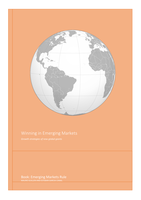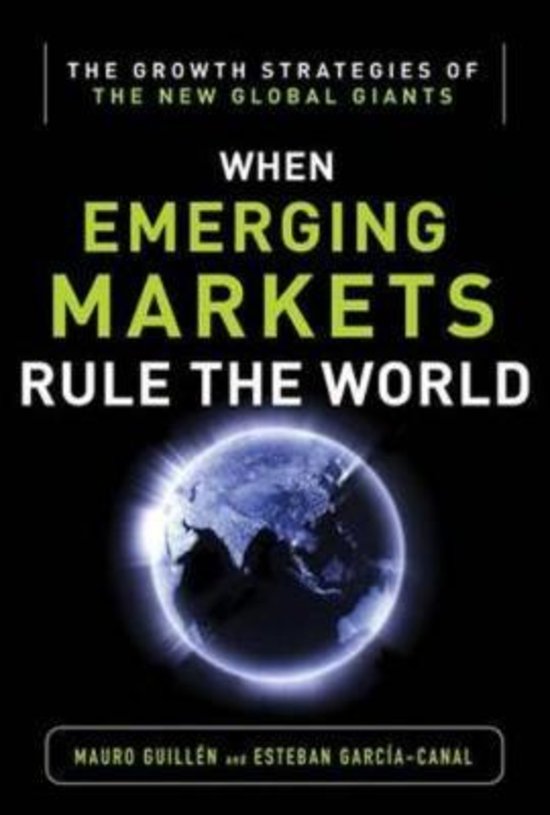https://upload.wikimedia.org/wikipedia/commons/thumb/0/0e/Globe_centered_in_the_At
lantic_Ocean_(green_and_grey_globe_scheme).svg/2000px-
Globe_centered_in_the_Atlantic_Ocean_(green_and_grey_globe_scheme).svg.png
https://upload.wikimedia.org/wikipedia/commons/thumb/0/0e/Globe_centered_in_the_At
lantic_Ocean_(green_and_grey_globe_scheme).svg/2000px-
Globe_centered_in_the_Atlantic_Ocean_(green_and_grey_globe_scheme).svg.png
Winning in Emerging Markets
Growth strategies of new global giants
Book: Emerging Markets Rule
MAURO GUILLEN AND ESTEBAN GARCIA-CANAL
,2
, Introduction. A permanent revolution
Emerging market = Those that are growing economically (above average) but not
necessarily demographically but do not have fully developed institutions such as stock
markets, labour markets, and legal systems.
Least developed Emerging Developed
Frontier markets
countries markets markets
Emerging market multinational = The firm must have assets and employees located outside
of its home country (in an emerging market). Therefore, not every EMM firm from an
emerging market is necessarily an EMM.
So, you need to have products and employees abroad to be an emerging market
multinational
Common characteristics of Emerging Market Multinationals:
- They are not industry-specific = They can be found in heavy industries and light
ones, high-tech and low-tech, extraction and information services.
- They are often closer than old-line firms tot their foundation figures and stories =
Nowadays, it is more important to know/explain how a company has started. For
example, Ford became such a multinational by working together with Hitler. Such
events would not be accepted nowadays.
- They are less tied than traditional multinationals to the often crippling effects of
having to produce short-term results to satisfy impatient financial markets =
Emerging Market Multinationals tend to have a ‘go-for-broke mentality’ (stressing
long-term results over satisfying analysts’ expectations)
- They often have a lot of knowledge and experience
- They look at the world truly globally = Often multinationals see problems in doing
business in an emerging market because of its institutional voids. However, EMM do
not have this challenge anymore because they know how to deal with bad
infrastructure and unreliable banks for example. So, EMM’s see opportunities in the
countries that multinationals see headaches in.
- They often have a home-field advantage = The institutional voids could be an
advantage for EMM’s
List of emerging markets:
- BRIC(S) =Brazil, Russia, India, China (and South Africa)
- MIST/MINT = Mexico, Indonesia, South Korea/Nigeria and Turkey
- CIVETS = Colombia, Indonesia, Vietnam, Egypt, Turkey and South Africa
- Next Eleven = Bangladesh, Egypt, Indonesia, Iran, Mexico, Nigeria, Pakistan,
Philippines, South Korea, Turkey and Vietnam
- EAGLEs (nest) = Emerging and Growth leading economies
Emerging markets will account for 79% of global growth between 2015 and 2025
Emerging markets contribute more to world economic growth than advanced markets
3
,Often we believe that environmental issues are bad for the growth on economic level.
However, weak states and poor political systems are also critical
issues that should not be forgotten.
Traditional role of emerging and developing markets =
Providing natural resources and cheap labour. However, not all
EMM have natural resources.
Global growth = The world, advanced economies, and emerging
markets all have the same flow, only the level of its differs
Difference in
A 6% growth of China – Is much more Growth A 20% growth of Venezuela – Is
impressive because of the quantity less impressive. If you start with
nothing it is easier to grow in
percentages
You really have to look at a country to find what their growth is based on. Is it on gold or tin
for example, it only affects the growth, but not the economic situation or purchasing power
of the citizens.
Production or factories would be more effective for an increase in purchasing power
Physical infrastructure = The basic physical structures required for an economy to survive
and function, such as transportation networks, a power grid and waste disposable systems.
Intellectual infrastructure = The human component – knowledge, skills and abilities –
required for a business and organizations to function effectively.
Imaginative infrastructure = The way to success – how you are going to achieve your goals,
sometimes without even knowing the path
How EMM enabled to take over the world:
- They are growing much faster because (economically);
o They are able to talk their language
o They are closer to the ground where the greatest growth is occurring They
are using the robust economic growth of their home market to provide a
sound base for international expansion
- They are growing much faster (demographically);
o A growing middle class of consumers and workers
X Demographic growth poses political instability
- EMM can cope better with political change = The regimes are often fragile and
complex
- Because they often lack good infrastructure, they start to develop themselves more
and become more productive. For example; when there is the challenge of securing
reliable electricity, industrial entrepreneurs began to supply their own and in the
process sometimes discovered whole new fields of endeavour
4
, Opportunities for emerging markets:
Population growth The population of emerging markets grow faster
Consumption
growth More people will be in the middle class
Urbanization Cities are growing much faster
Trade liberization More free trade agreements
Challenges for emerging markets:
- Institutional voids = Institutions that are missing or not functioning as expected in
emerging markets.
o Weak rule of law, such as corruption, child labour, poor law system
o Weak financial institutions (banking system)
o Lack of transparency (stock market)
- Inadequate infrastructure
Global challenge = Firms of emerging market that have successfully internationalized
o They move up the value chain and become leading companies without
significant knowledge, skills or resources
o They have innovative business models (more adaptive)
o Taking on traditional multinationals at home and abroad, in a short time
period
Today, it is not who you know or what you know or where you learned it but how quickly you
can adapt to market, economic, and geopolitical conditions that change with almost
unbelievable speed.
Winning in emerging markets is not simply about inventing gadgets, creating brand equity,
and designing the best organizational structure. The new rules are built for speed and
designed for maximum flexibility.
Axioms of global competition:
1. Execute, strategize, and then execute again
2. Cater to the niches
3. Scale to win
4. Embrace chaos
5. Acquire smart
6. Expand with abandon
7. No sacred cows
Bottom of the Pyramid = The world’s poorest citizens constituting an invisible and unserved
market blocked by challenging barrier that prevent them from realising their human
potential for their own benefit, those of their families, and that of society.
- They often live in the rural areas (more money is earned in the urban areas)
5
, - They are very poorly served. The roads are often bad and therefore it takes much
more time and effort to bring your products to the rural areas. Therefore, urban
areas are more attractive for businesses (easier to reach)
- They are dominated by the informal economy = The part of an economy that is
neither tax nor monitored by any form of government. Their activities are not
included in the gross national product (GNP). This may be bad, but they create a lot
of job opportunities and it increases the wealth of the small villages
- They are relatively inefficient and uncompetitive – They spend most of their money
on food
The spending pattern of the BoP (ranked):
1. Food
2. Water
3. Energy
4. Housing
5. Transportation
6. Health
7. ICT
The spending pattern of emerging markets on ICT:
1. Asia
2. Latin America
3. Eastern Europe
4. Africa
How to traditionally make your business successful in the BoP:
- Who is my customer
- What do they want
- How are you going to provide it
When doing business with BoP, you need to take the 4 A-factors into account:
- Acceptability = Does it fit in their culture, for example tampons would fit the
European culture, but not the Arabic. Or gardening tools flopped in Latin America’s
yard less neighbourhoods.
- Affordability = Can people afford buying your product
- Availability = How do I get my product to the customer
- Awareness = How do I make people aware that my product is on the market –
marketing. For example, 44% of consumers in China make their decisions inside
stores, compared to 24% in the US. This shows a different type of marketing.
Example affordability = Selling cigarettes per piece. You have to take into account that their
income is fluctuating tremendously, because one day they have good business, the other day
they have nothing.
Availability problems:
- Absence of distribution chains
- Irregular and unreliable cash flows
6





